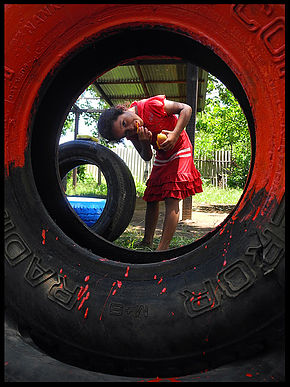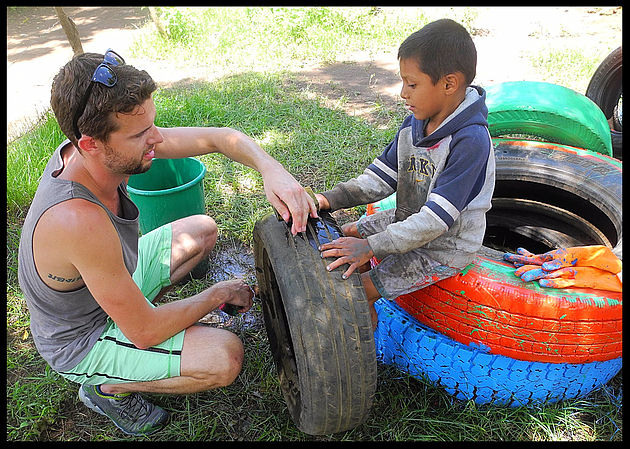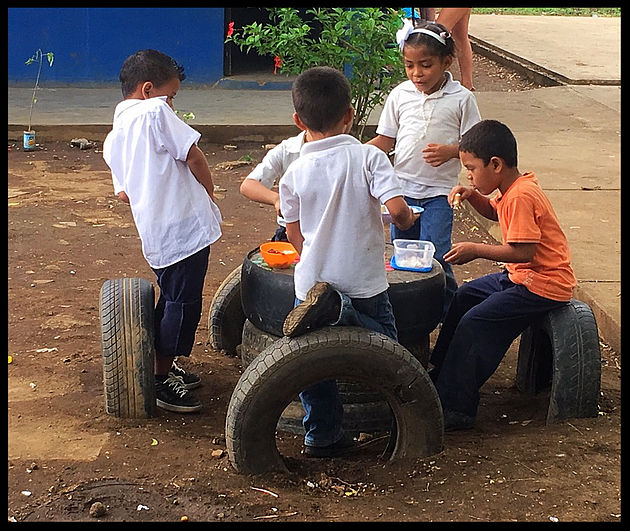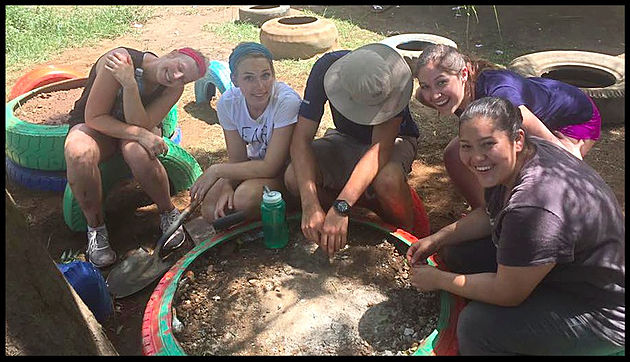We had already begun to sweat profusely under the morning sun as my group and I stood in the dried up school yard, staring upwards at a tall heap of old truck tires piled against a crumbly brick wall. Just behind us, Nicaraguan school kids in their crisp, white button-up school shirts tucked into navy trousers and navy skirts ran amok through the lot: a barren school yard characterized by patches of fading green grass, scattered litter, and a few ragged, skinny dogs.
Our group was to spend a couple weeks working at a local school in Leon, Nicaragua, engaged in various tasks to make improvements as best we could. This included a few health and nutrition-based outdoor activities, educational murals, and building permanent tables and chairs using repurposed tires for the kids that would enhance their playground and schoolyard.
This was a fantastic project – recycling would-be garbage into something functional and visually appealing for the students would be an awesome experience- reusing tires, teaching the importance of recycling and minimizing waste, helping in the school, and most importantly, getting the kids involved.

We stood in the sun, acknowledging the huge pile of dirty, old, and mosquito-infested tires. It was hot, the playground was a cacophony of schoolyard chaos, and the tires were filthy and heavy. None of us had taken on such an endeavor before.
We got to it. It’s what we came here for… to contribute in what ways were needed in what ways we could.
Throughout the duration of our project, we divided and conquered: some of us took to washing the grime and mud off the tires, others took to mixing the cement, or digging deep holes in the ground just outside the classroom, and some of us took to distracting the kids from clamouring all over the tires, or dipping their small hands in thick red paint, or running carefree in the vicinity of sharp tools by providing the kids with crayons and colored pencils and paper to draw on at a safe distance away.
 It was a bigger job than we had imagined. The excited and fast-speaking Spanish of the Nica kids was clamorous, and, while a few of us were confident Spanish speakers, most in my North American group spoke only a few of the Spanish words we had picked up since our arrival:
It was a bigger job than we had imagined. The excited and fast-speaking Spanish of the Nica kids was clamorous, and, while a few of us were confident Spanish speakers, most in my North American group spoke only a few of the Spanish words we had picked up since our arrival:
“Con ciudado.” Be careful.
“Camina despacio por favour.” Walk slowly please.
“Silencio” Shhhhhhhh.
“Quieres color?” Do you want to color?
It was the language essential for commandeering a playground.
We worked through the day. A dozen or so tires were used, some buried vertically as deep as halfway up the tire, while others were bolted together, 3 tires deep and secured into a tight stack. The stacks were then filled to the brim with cement to form a solid surface for the “table.” The idea was that the vertically half-buried tires would serve as seats, positioned around the side-stacked tires, which would serve as lunch tables for the kiddies. It was a solid day’s work, sweating throughout, and as the afternoon wore on and the school day came to a close, we walked our dirty selves home to clean up and relax.

We returned the next morning, ready to finish the job we started and add some color to the dusty school yard in the way of bright greens and deep reds and vivid blues.
In the warming morning light, we walked through the school fence and into the yard, welcomed by the Spanish shouts of cheerful children. Then, one of the girls in my group smiled and said to us, “Look. They are already using the tires as tables.”
Sure enough, the kids were happily sitting around the unfinished tire tables, eating food, which was parcelled out atop the drying cement surface or fiddling with a toy as they straddled the tires for seats and chattered away to each other. It was awesome.
We set about painting our tire tables and chairs, in which the kids whole-heartedly jumped in to help. We did a pretty good job of maintaining a balance between involving the kids by allowing them to paint their own lunch tables, and also trying to keep the paint off their clothes. I’d say it was a 50/50 success rate of ending the day with paint-free kids.
It was just a simple thing. Collect tires, wash them off, stack them up, paint them pretty, and there you go. A little cement and a little color and you have a long-term addition to their schoolyard that the kids loved.
The work was hard, but achievable.
The Spanish on our side was minimal, but there’s no doubt the playful, and excited exchanges that were non-stop every minute we were there was communicated so clearly. Playful smiles and dozens of kids crowded around us to ask us: What were our names? Where were we from? How old were we?
The engagement we had each day with these kids gave meaning to our project.
We may not have been able to contribute to the life-long learning of the kids, or deliver life-changing lessons to the students in a way that would ensure them a straight and narrow track to college, solid jobs, and improved way of life.
We couldn’t guarantee all of that with the time we had.
But what we COULD do was give our time in a way that made someone else’s day a little better.
We could play games with the kids.
We could try to learn a few words of their language and make those few days of school for them have that much more joy.
We could involve them.
We could teach them a few things about recycling and community, and leave something behind for them that was useful and memorable.
We made those days count. We made them important and special and “poco y poco” (little by little), we knew we could take steps towards doing our part in what ways we could.
And in Nicaragua, that’s just what we did.




